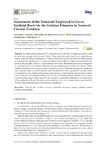Mostrar o rexistro simple do ítem
Assessment of the Materials Employed in Green Artificial Reefs for the Galician Estuaries in Terms of Circular Economy
| dc.contributor.author | Carral Couce, Luis | |
| dc.contributor.author | Camba, C. | |
| dc.contributor.author | Lamas, M.I. | |
| dc.contributor.author | Rodríguez-Guerreiro, María J. | |
| dc.contributor.author | Cartelle Barros, Juan José | |
| dc.date.accessioned | 2021-01-21T16:57:51Z | |
| dc.date.available | 2021-01-21T16:57:51Z | |
| dc.date.issued | 2020 | |
| dc.identifier.citation | Carral, L.; Camba Fabal, C.; Lamas Galdo, M.I.; Rodríguez-Guerreiro, M.J.; Cartelle Barros, J.J. Assessment of the Materials Employed in Green Artificial Reefs for the Galician Estuaries in Terms of Circular Economy. Int. J. Environ. Res. Public Health 2020, 17, 8850. https://doi.org/10.3390/ijerph17238850 | |
| dc.identifier.issn | 1661-7827 | |
| dc.identifier.uri | http://hdl.handle.net/2183/27217 | |
| dc.description.abstract | [Abstract] To exploit marine resources in a sustainable way, efficient management systems must be used such as green artificial reefs (GARs). These reefs are mostly made up of renewable and organic materials. When adopting the circular economy (CE) model, industrial processes must be reconsidered. By adapting how conventional artificial reefs (CARs) are engineered and produced to embrace the principles of the CE, certain materials can be used. Renewable resources are designed to be reintroduced into the biosphere without producing harmful organic residues or nutrients. Within a framework that covers economic, environmental and social considerations, this study offers four new proposals related to substituting the materials destined for the components in an artificial reef. For the first time, two different methodologies were applied to determine the best alternative in terms of its contribution to both sustainability and CE. From the results obtained, the best solutions are in line with substituting a certain amount of the cement and sand with mussel shells. The importance of the results lies in the fact that the canning industry in Galicia (northwest Spain) generates shell residues which promote grave environmental consequences. | es_ES |
| dc.description.sponsorship | Xunta de Galicia; CN-10MMA003CT | es_ES |
| dc.language.iso | eng | es_ES |
| dc.publisher | MDPI | es_ES |
| dc.relation.uri | https://doi.org/10.3390/ijerph17238850 | es_ES |
| dc.rights | Atribución 4.0 | es_ES |
| dc.rights.uri | http://creativecommons.org/licenses/by/4.0/ | * |
| dc.subject | Arrecifes artificiales | es_ES |
| dc.subject | Economía circular | es_ES |
| dc.subject | Energías renovables | es_ES |
| dc.subject | Residuos orgánicos | es_ES |
| dc.subject | Artificial reef | |
| dc.subject | Circular economy | |
| dc.subject | Renewable resources | |
| dc.subject | Organic residues | |
| dc.subject | Mussel industry | |
| dc.subject | Sustainability | |
| dc.title | Assessment of the Materials Employed in Green Artificial Reefs for the Galician Estuaries in Terms of Circular Economy | es_ES |
| dc.type | info:eu-repo/semantics/article | es_ES |
| dc.rights.access | info:eu-repo/semantics/openAccess | es_ES |
| UDC.journalTitle | International Journal of Environmental Research and Public Health | es_ES |
| UDC.volume | 17 | es_ES |
| UDC.issue | 23 | es_ES |
| UDC.startPage | 8850 | es_ES |
| dc.identifier.doi | 10.3390/ijerph17238850 |
Ficheiros no ítem
Este ítem aparece na(s) seguinte(s) colección(s)
-
CIT-GEM - Artigos [21]
-
GI-CIM - Artigos [27]
-
GI-SISTER - Artigos [37]
-
GI-GRIDP - Artigos [12]






